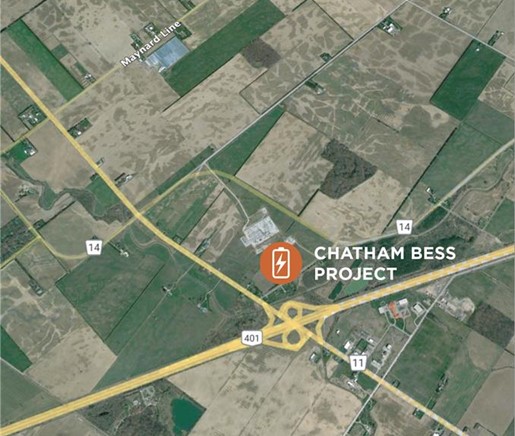| Location: | Chatham-Kent |
| Country: | Canada |
| Power: | Targeted 300-600 MW (x4 hrs) |
| Province: | Ontario |
| Status: | In development |
Details
Li-Ion Batteries
Project Overview
Boralex has secured land options for a battery energy storage system (BESS) project near the existing Chatham Switching Station, owned by Hydro One, in the Municipality of Chatham-Kent, Ontario. The Chatham project is anticipated to have a capacity targeting 300-600 MW for 4 hrs. Once constructed, the project will help meet the energy capacity need identified by Ontario’s Independent Electrical System Operator (IESO) and will also benefit the overall Ontario electricity system. Commercial operation of this project is planned for spring 2025.
Project Details
The project will consist of containerized batteries, inverters, medium voltage transformers, gravel internal access roads, buried collector and communication cabling, a small transmission substation and potential garage and operations and maintenance building. The layout of the infrastructure within the project’s footprint has yet to be confirmed and will be determined through additional engineering studies, equipment procurement and an environmental assessment. The Project will connect to the Hydro One transmission system via one or more 230-kilovolt interconnections at the Chatham switching station.
The project will provide reliable power capacity by drawing and storing energy from the grid during off-peak periods and releasing it back to the Ontario grid when energy demand is at its peak. The project is expected to provide significant benefits to Ontario’s ratepayers by reducing the need and cost associated with using gas-fired power plants during times of peak demand as well as helping to clean Ontario’s electricity system.
Proposed Location
The project would be located in the Municipality of Chatham-Kent, Ontario.

Project Updates
- The project has qualified to participate in the IESO Expedited and Long-Term 1 Request for Proposals (E- LT1 and LT1 RFP).
- Boralex plans to submit the project into the IESO’s E-LT1 RFP in February 2023.
- Boralex is looking for feedback on the project from stakeholders and Indigenous Nations. To provide feedback, please contact us: info@boralex.com.
Documentation
Chatham Community and Indigenous Engagement Plan
Open House Boards - December 13, 2022
Open House Boards - November 2, 2022
Frequently Asked Questions
What is battery energy storage?
Battery storage, or battery energy storage systems, are devices that enable energy from power sources, like hydroelectric, wind, and even the electrical grid itself, to be stored and then released when customers need power most. Lithium-ion batteries, which are used in mobile phones and electric cars, are currently the most-used storage technology for large scale energy storage projects to help electricity grids ensure a reliable supply of energy.
Why is energy storage important?
Battery energy storage technology has a key part to play in ensuring homes and businesses can be powered, even when the sun isn’t shining, or the wind has stopped blowing. The energy system must match energy supply with customer demand. Battery energy storage systems charge up when energy sources are producing more energy than customers need and discharge during times of peak demand to provide a reliable, steady supply of energy.
How does a battery energy storage system work?
Battery energy storage systems are considerably more advanced than the batteries you keep in your kitchen drawer or insert in toys and other electronics. A battery energy storage system can be charged by electricity generated from renewable energy, like wind and hydroelectric power, as well as drawing and storing energy from the grid during off-peak periods.
Intelligent battery software uses algorithms to coordinate energy production and computerised control systems are used to decide when to keep the energy to provide reserves or release it to the grid. Energy is released from the battery energy storage system during times of peak demand, keeping costs down and electricity flowing.
What does a battery energy storage site look like?
A site would consist of containerized batteries, inverters, medium voltage transformers, gravel internal access roads, buried collector and communication cabling, a small transmission substation, potential garage and operations and maintenance building, and connect to either a transmission system or distribution system depending on the system of the project.
What effects will the Chatham project have on the environment?
The project will have a positive impact on the environment and fight climate change by mitigating the variability of renewable energy production and the cycling of natural gas facilities. This helps ensure the reliability and stability of the electricity grid as it fosters the penetration of renewable energies. It also helps to reduce harmful emissions as it lightens the load of traditional energy generation systems that rely on fossil fuels, such as gas-fired power plants.
Potential environmental effects will be determined during the Class Environmental Assessment (EA) for Minor Transmission Facilities in accordance with the Ontario Environmental Assessment Act. The Class EA is a streamlined process for transmission projects anticipated to have a predictable range of environmental effects that can feasibly be mitigated with protection measures. More information about the Class EA can be found on the Hydro One website here.
Is energy storage clean?
Yes. Energy storage usually needs a minimal footprint and does not require pipelines for its operation. It stores energy when it is abundant and releases it when more power is needed on the grid. Moreover, it generates almost no waste or polluting emissions. As such, energy storage helps to reduce harmful emissions as it lightens the load of traditional energy generation systems that rely on fossil fuels, such as gas-fired power plants. This translates in cleaner and more reliable energy for Ontario’s homes and businesses.
Contact Us
For any questions or more information:
437-421-5238
info@boralex.com